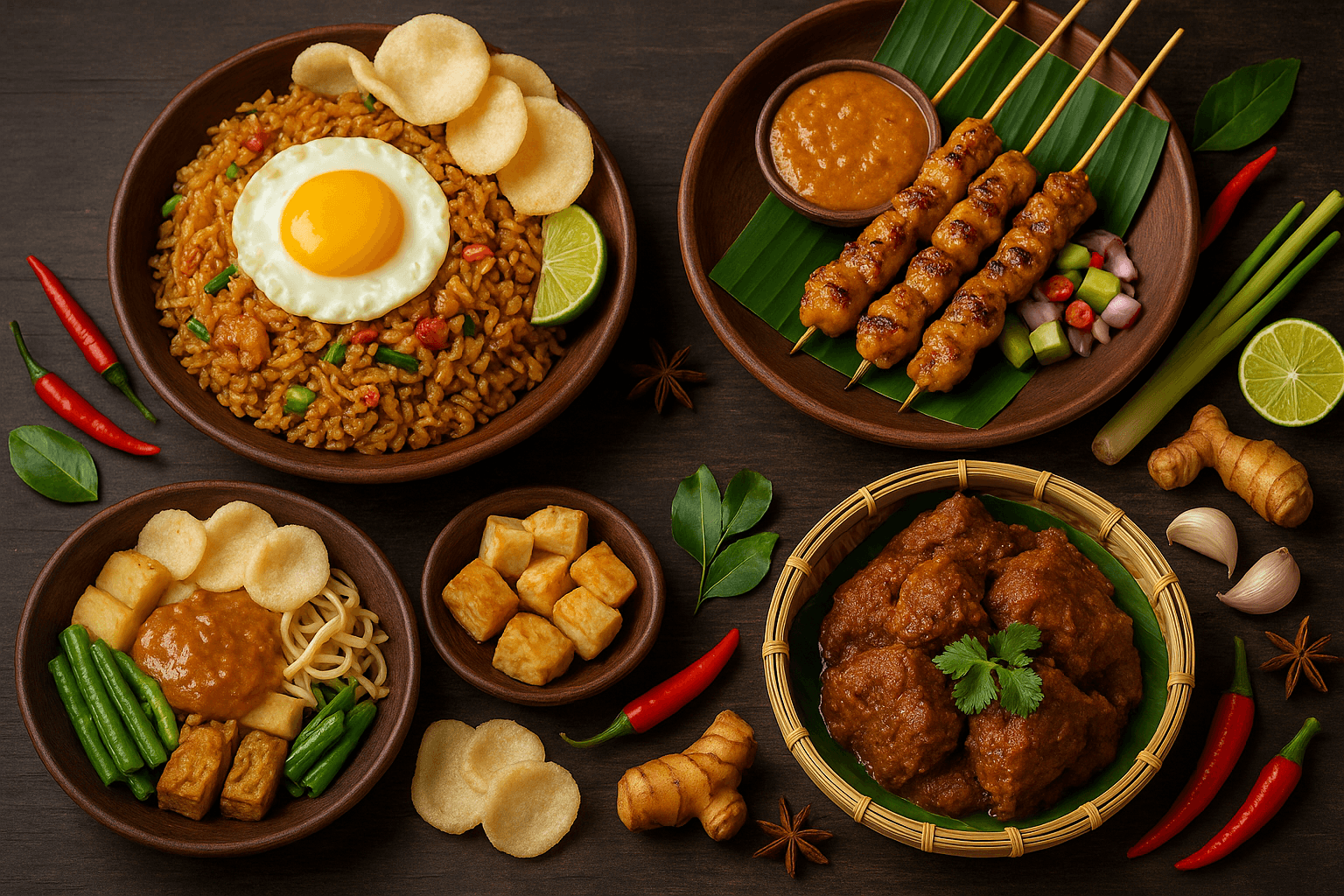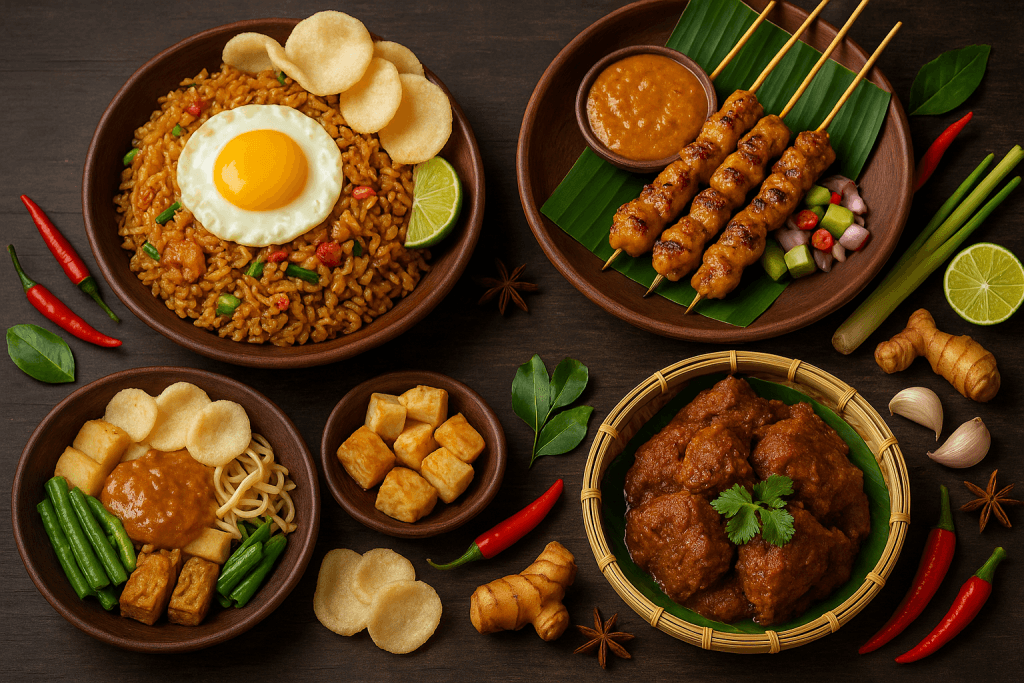Embarking on A Culinary Adventure Across Indonesia: Authentic Flavors and Traditions means stepping into a sensory world where spices dance, aromas tell stories, and each dish reflects centuries of cultural fusion. From the tropical islands of Sumatra to the serene beaches of Bali, Indonesia’s cuisine captures the heart of Southeast Asia’s diversity. This archipelago of over 17,000 islands is a living testament to how geography, religion, and trade routes shape culinary identity.
Indonesian food is not simply a collection of recipes. It is a celebration of harmony between nature and community. The balance of sweetness, saltiness, sourness, bitterness, and heat defines every plate. Whether you’re savoring a humble street-side satay or a royal palace feast, you are participating in a living culinary tradition that continues to evolve.
Throughout this A Culinary Adventure Across Indonesia: Authentic Flavors and Traditions, we will explore the signature dishes, traditional cooking methods, cultural meanings, and regional specialties that make Indonesian cuisine one of the world’s most vibrant gastronomic landscapes.
See more:Top 10 Must-Try Dishes in Indonesia Cuisine

The Soul of Indonesian Cuisine
At the heart of A Culinary Adventure Across Indonesia: Authentic Flavors and Traditions lies a deep respect for ingredients and balance. Indonesian food reflects the country’s rich biodiversity — from volcanic soils to coastal reefs, each ingredient carries local identity.
The Role of Spices
Indonesia is famously known as the “Spice Islands.” Cloves, nutmeg, turmeric, galangal, lemongrass, coriander, and cinnamon originated here, shaping not just local dishes but global culinary history. Traders from India, China, and the Middle East brought new flavors that were quickly absorbed into Indonesian kitchens.
Spices are not just for taste. They represent medicine, culture, and spirituality. In many traditional households, turmeric is used to purify, ginger to warm the body, and coconut to symbolize unity. Every Indonesian spice blend — known as bumbu — tells a regional story.
The Balance of Flavors
What makes A Culinary Adventure Across Indonesia: Authentic Flavors and Traditions remarkable is the balance between contrasting sensations. Sweet kecap manis, fiery sambal, earthy peanuts, and tangy tamarind often share the same dish, creating complexity and depth.
Regional Diversity in Indonesian Food
Indonesia’s culinary map is as diverse as its people. Each island group adds its distinctive touch, influenced by geography, history, and ethnicity.
1. Sumatra: Bold and Fiery
Sumatran cuisine, especially from Padang, is known for its bold flavors and generous use of coconut milk and chili. The famous Rendang — slow-cooked beef in coconut and spices — symbolizes patience, strength, and honor. This Minangkabau delicacy has even been recognized by UNESCO as part of Indonesia’s intangible cultural heritage.
Other notable dishes include Gulai Ikan (spicy fish curry) and Ayam Pop (fried chicken with a light coconut sauce). The intensity of flavor defines Sumatran food, perfect for lovers of spice and heat.
2. Java: Harmony and Sweetness
Moving eastward, Javanese cuisine balances sweetness and subtlety. In cities like Yogyakarta and Surakarta, Gudeg (young jackfruit stew cooked with palm sugar and coconut milk) exemplifies refinement. Traditional markets are filled with nasi liwet, soto ayam, and tempe bacem — dishes rooted in centuries-old royal traditions.
In this part of A Culinary Adventure Across Indonesia: Authentic Flavors and Traditions, food is not merely sustenance but an art of moderation. The Javanese concept of “rasa” — a sense of harmony — is reflected in every bite.
3. Bali: Spiritual and Fresh
Bali adds a sacred dimension to the culinary journey. Balinese cuisine blends Hindu rituals with fresh tropical produce. Babi Guling (roast suckling pig), Lawar (spiced vegetable salad), and Sate Lilit (minced fish satay) are offerings as much as meals. Coconut, lime leaves, shallots, and chili dominate Balinese kitchens, offering a balance between fragrance and flavor.
Bali also represents Indonesia’s modern culinary renaissance — where tradition meets global creativity.
4. Sulawesi: Complexity and Contrast
The island of Sulawesi brings a different rhythm. Makassar’s Coto Makassar, a beef soup enriched with peanuts and spices, reflects Arab and Chinese influences. Palu’s Kaledo (oxtail soup) and Manado’s Rica-Rica dishes highlight intense chili and herbs. Coastal towns rely on seafood — grilled fish, squid, and shrimp are staples of local feasts.
5. Kalimantan: Earthy and Indigenous
Borneo, or Kalimantan, offers an earthy flavor profile inspired by indigenous Dayak tribes. Grilled forest meats, bamboo-cooked rice (nasi bambu), and river fish curries connect cuisine with jungle traditions. These recipes are often cooked over wood fire, preserving authenticity and aroma.
6. Maluku and Papua: The Roots of the Spice Trade
The Maluku Islands, once the world’s spice epicenter, are filled with clove trees and nutmeg forests. Traditional dishes like Ikan Kuah Kuning (fish in turmeric broth) and Papeda (sago porridge) represent simplicity and heritage. Papua’s highlands offer a different landscape — sweet potatoes, wild vegetables, and grilled meats shaped by tribal customs.
Each island adds depth to A Culinary Adventure Across Indonesia: Authentic Flavors and Traditions, proving that Indonesian food is not a single identity but a mosaic of experiences.
Traditional Cooking Techniques
The mastery of A Culinary Adventure Across Indonesia: Authentic Flavors and Traditions lies in its cooking techniques — ancestral methods that emphasize patience, precision, and respect for ingredients.
1. Grinding and Blending (Ulek dan Tumbuk)
Before modern blenders, Indonesians used stone mortars (ulekan) to grind spices. The rhythm of pounding creates a distinct texture and aroma impossible to replicate mechanically. Sambal, bumbu rendang, and pepes (banana leaf wraps) rely on this manual artistry.
2. Banana Leaf Wrapping (Pepes)
Cooking with banana leaves imparts subtle fragrance and moisture. Dishes like Pepes Ikan and Pepes Tahu are steamed or grilled in leaf parcels, creating natural flavor infusion. It’s sustainable, aesthetic, and deeply traditional.
3. Open Fire Grilling (Bakar)
From street satay stalls to rural kitchens, grilling defines Indonesian street food culture. Charcoal-grilled meats, seafood, and corn are common sights across night markets. The smoky aroma is synonymous with festivity.
4. Slow Cooking (Rendang Technique)
The rendang method, involving hours of simmering in coconut milk and spices, represents endurance. The result is a rich caramelized texture that embodies perfection. This slow-cook philosophy teaches patience and appreciation.
Street Food Culture in Indonesia
No A Culinary Adventure Across Indonesia: Authentic Flavors and Traditions is complete without exploring the vibrant world of Indonesian street food. The streets of Jakarta, Bandung, and Surabaya come alive at night with sizzling woks, colorful carts, and irresistible smells.
Popular Street Foods
Satay: Skewered meats grilled over charcoal, served with peanut sauce or sweet soy glaze.
Bakso: Savory meatballs in clear broth, a national comfort food.
Martabak: Sweet or savory stuffed pancakes filled with chocolate, cheese, or minced beef.
Gorengan: Deep-fried snacks — tofu, banana, and tempe — found everywhere.
Nasi Goreng: Indonesia’s iconic fried rice, infused with kecap manis and topped with a fried egg.
Street food captures Indonesia’s communal spirit. People from all walks of life share benches, stories, and laughter over simple yet soul-warming dishes.
The Role of Rice and Noodles
Rice is life in Indonesia. Known as nasi, it accompanies nearly every meal. In A Culinary Adventure Across Indonesia: Authentic Flavors and Traditions, rice symbolizes prosperity, fertility, and gratitude.
Rice Varieties
Nasi Putih (plain white rice) is a daily staple.
Nasi Uduk (fragrant coconut rice) is common at breakfast.
Nasi Kuning (yellow rice) is served at celebrations, symbolizing gold and good fortune.
Nasi Campur offers a medley of side dishes, showing culinary diversity on one plate.
Noodles (mie) are equally loved. Mie Goreng (fried noodles) and Soto Mie (noodle soup) reflect Chinese influence blended with Indonesian taste.
Indonesian Sauces and Condiments
An integral part of A Culinary Adventure Across Indonesia: Authentic Flavors and Traditions is its sauces — the secret that unites all dishes.
Sambal: The Fiery Heart
There are hundreds of sambal varieties — sambal terasi (shrimp paste), sambal matah (raw Balinese chili mix), sambal bawang (shallot chili), and sambal ijo (green chili). Each region adds its twist, and every meal feels incomplete without it.
Kecap Manis: Sweet Soy Magic
This thick, caramel-like soy sauce adds balance to grilled meats, noodles, and fried rice. Its sweetness defines many Javanese dishes and embodies comfort.
Culinary Symbolism and Rituals
Food in Indonesia often carries spiritual meaning. Meals are offerings to gods, ancestors, and community. During ceremonies such as weddings or Nyepi (Balinese New Year), dishes are arranged with symbolic care.
For example:
Tumpeng, a cone-shaped yellow rice dish, represents gratitude and harmony.
Kolak (banana dessert in coconut milk) marks Ramadan’s breaking of the fast.
Jajan pasar (traditional sweets) symbolize unity in diversity.
These customs reveal that A Culinary Adventure Across Indonesia: Authentic Flavors and Traditions is not just about flavor — it’s about connection.
Modern Indonesian Cuisine
Contemporary chefs are redefining A Culinary Adventure Across Indonesia: Authentic Flavors and Traditions through innovation. Fine-dining restaurants in Jakarta, Bali, and Bandung reinterpret classics with modern techniques while preserving authenticity.
Fusion dishes such as rendang pasta, tempe burger, and sambal aioli are becoming popular globally. Indonesian ingredients are now appearing in Michelin-star kitchens, introducing the world to flavors once known only locally.
This evolution shows how Indonesia’s culinary identity remains dynamic — deeply rooted yet globally relevant.
Famous Beverages and Desserts
The sweet conclusion of A Culinary Adventure Across Indonesia: Authentic Flavors and Traditions includes beverages and desserts that refresh and delight.
Beverages
Es Cendol: A colorful iced drink with pandan jelly, coconut milk, and palm sugar.
Teh Tarik: Frothy pulled tea from Sumatra and Java.
Kopi Tubruk: Strong unfiltered coffee symbolizing Indonesian hospitality.
Desserts
Klepon: Sticky rice balls filled with palm sugar and coated with coconut.
Pisang Goreng: Fried banana, a comfort snack from street stalls.
Lapis Legit: Layered spice cake symbolizing patience and craftsmanship.
Tourism and Culinary Trails
Culinary tourism is central to A Culinary Adventure Across Indonesia: Authentic Flavors and Traditions. Travelers explore regions not only for landscapes but for food trails — tasting diversity from warungs (local eateries) to fine-dining venues.
Popular Food Destinations
Jakarta: Street food capital with international fusion dining.
Yogyakarta: Heritage dishes like Gudeg and Bakpia.
Padang: Spicy buffets with endless curry options.
Bali: Tropical dining experiences merging nature and culture.
Manado: The ultimate spot for seafood and chili lovers.
The Indonesian government has recognized food tourism as a key cultural export, integrating it into sustainable travel initiatives. Culinary experiences like cooking classes, spice garden tours, and traditional market visits enhance national pride.
Preserving Authentic Traditions
Amid globalization, preserving authenticity is vital. A Culinary Adventure Across Indonesia: Authentic Flavors and Traditions calls attention to local farmers, fishermen, and artisans who keep heritage alive.
Community-based food programs teach younger generations traditional recipes. Women’s cooperatives in villages produce handmade spices and snacks. These efforts ensure that future Indonesians inherit both taste and tradition.
Sustainability also plays a crucial role — organic farming, eco-packaging, and reduced food waste align with Indonesia’s growing green movement.
International Recognition
Indonesia’s culinary art is gaining worldwide recognition. UNESCO has acknowledged several dishes as cultural treasures. Rendang was voted the world’s most delicious dish by CNN, while Nasi Goreng and Satay consistently rank among global favorites.
Chefs like William Wongso and Petty Elliott have brought Indonesian cuisine onto the international stage. Restaurants from London to New York now feature Indonesian tasting menus, allowing global diners to experience A Culinary Adventure Across Indonesia: Authentic Flavors and Traditions firsthand.
Conclusion
A Culinary Adventure Across Indonesia: Authentic Flavors and Traditions is more than a gastronomic journey. It’s a tribute to a nation defined by diversity, resilience, and creativity. Every spice, every aroma, and every shared meal reflects centuries of cultural exchange and the spirit of togetherness.
From the fiery kitchens of Padang to the serene temples of Bali, Indonesian cuisine remains a living expression of harmony between people and nature. Whether enjoyed on bustling streets or tranquil shores, the flavors of Indonesia continue to inspire the world — reminding us that true authenticity lies in the balance of tradition and innovation.

